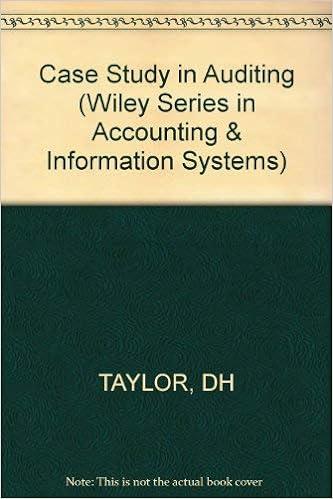Question
For the year ended December 31, 2013: Net Revenues $32,200 Cost of services provided 11,400 Depreciation expense 6,500 Operating income $14,300 Interest expense 3,800 Income
For the year ended December 31, 2013:
| Net Revenues | $32,200 |
| Cost of services provided | 11,400 |
| Depreciation expense | 6,500 |
| Operating income | $14,300 |
| Interest expense | 3,800 |
| Income tax expense | 3,200 |
| Net income | $7,300 |
At December 31, 2013:
| Assets | |
| Cash and short-term investments | $2,800 |
| Accounts receivable, net | 9,800 |
| Property, plant, and equipment, net | 77,400 |
| Total assets | $90,000 |
| Liabilities and Stockholders' Equity | |
| Accounts payable | $1,500 |
| Income taxes payable | 1,600 |
| Notes payable (long term) | 47,500 |
| Paid-in capital | 10,000 |
| Retained earnings | 29,400 |
| Total liabilities and stockholders' equity | $90,000 |
The information above is about a current case taking place. The conversation with regard to this case is as follows:
Mr. Smith: "I've been talking with my accountant about our captial expansion needs, which will be considerable during the next couple of years. To stay in a strong competitive position, we're constantly buying new pieces of earthmoving equipment and replacing machinery that has become obsolete. What it all comes down to is financing, and it's not easy to raise $10 million to $20 million all at once. There are a number of options, including dealer financing, but the interest rates offered by banks are usually lower.
Your Words: From reviewing your balance sheet, I can see that you've got a lot of notes payable already. How is your relationship with your bank?
Mr. Smith: Actually we use several banks and we have an excellent credit history, so getting the money is not a problem. The problem is we already owe more than $40 million on all of those notes and I don't want to get overextended.
Your Words: Have you considered long term leases?
Mr. Smith: Yes. This is essentially how dealer financing works. Usually it is arranged as a lease with an option to buy the equipment after a number of years. We've been actively looking into this with our Cat dealer for a couple of machines that we need to put on a big job immediately. I can show you one of the contracts.
Your Words: Ok, this sounds like a long term capital lease.
Mr. Smith: Yes, thats what my accountant called it. What are the accounting implications that i would be entering into that would put me at ease about this?
Your words: It would impact both your balance sheet & income statement, but in most respects long term capital lease is treated much like a long term note payable with a bank. Their are other sources of equity financing, have you looked into this?
Mr. Smith: We are a family business and want to stay that way. Our shares are publicly traded, but we're owned by family and employees. We have alot of retained earnings, but thats not the same as cash. Should we be issuing bonds?
Your Words: Issuing bonds is possible, but preferred stock would be a better option. Do you know about any of this option?
Mr. Smith: I do not know much about this. Is it like bonds payable?
Your Words: I'll make a note for you that explains the difference between common stock, preferred stock, and bonds payable.
A. Explain the accounting treatment of capital leases as compared to the accounting treatment of notes payable in terms that a nonaccountant could easily understand. In your answer include both the balance sheet and income statement effects of capital leases.
B. Assume you have reviewed the contract Mr. Smith provided concering the dealer financing agreement for the purchase of two new machines. You have determined that the lease agreement would qualify as a capital lease. The present value of the lease payments would be $2 million. Use the horizontal model (or write the journal entry) to show Mr. Smith how this leasse would affect the financial statements of his company.
C. Explain what Mr. Smith meant when he said "We've got alot of retained earnings, but that's not the same thing as cash." Review the balance sheet at December 31, 2013. In which assets are most of the company's retained earnings invested?
D. Explain to Mr. Smith what the similiarities and differences are between bonds payable, preferred stock, and common stock.
E. Why would you recommend to Mr. Smith that his company consider issuing $10 million to $20 million of preferred stock rather than bonds payable?
Step by Step Solution
There are 3 Steps involved in it
Step: 1

Get Instant Access to Expert-Tailored Solutions
See step-by-step solutions with expert insights and AI powered tools for academic success
Step: 2

Step: 3

Ace Your Homework with AI
Get the answers you need in no time with our AI-driven, step-by-step assistance
Get Started


